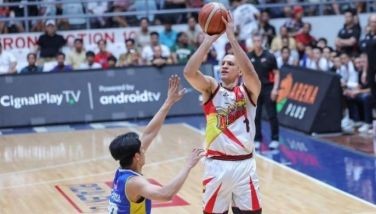Filipino diaspora

June 28, 2005 | 12:00am
The Middle East remains to be the top destination of Filipino overseas workers, followed by Asia, Europe and the Americas, and the other countries and territories.
Service workers continue to comprise the greater bulk of the total deployed, particularly domestic helpers, household workers, caretakers, waiters and bartenders. About 90 percent of these service workers were females and accounted for 36.2 percent of total deployed newly hired workers.
A gradual shift from low-end to higher-end occupation has taken place, with the hiring of professional/technical and workers, majority of them medical and health professionals, engineers, teachers, accountants, performing artists, and architects. Eighty-six percent of the newly hired workers are women, so it can be deduced, said Sto. Tomas, "that feminization of overseas employment is getting more pronounced."
The outflow of Filipino workers has been/is caused by the need for income far greater than they can find at home. Sto. Tomas said the dollar remittances coming from the OFWs "have kept the Philippine economy afloat especially during times of crisis." Income remittances from OFS comprised about two percent of the GNP in the eighties, and that contribution has more than doubled to 4.8 percent in the nineties. Official records, she said, show that dollar remittances channeled through banks have grown from US$1.5 billion in 1991 to US$6.0 billion in 2000. For 2004 alone, OFW dollar remittances amounted to US$8.5 billion, roughly 9.2 percent of the country’s national output.
As a strategy for empowerment, Sto. Tomas said overseas employment is an "enabling tool" to help them act on their own choice – a choice to get ahead in life and move up in the world; a choice to improve the lot of their immediate families and give them a future to look forward to."
Maruja M. B. Asis of the Scalabrini Migration Center, said the Philippines’ foray into international labor migration in the 1970s coincided with what scholars regard as the beginnings of a truly global migration. Filipinos supplied oil-rich Middle East countries with their labor needs, but, unlike other countries, the Philippines explored other countries, thus distributing today OFWs in nearly 200 countries and territories.
But what about the social costs borne by migrants? Asis spoke about the minus-side of overseas employment – the stress and strains families bear, the distortion of Filipino values, further erosion of Filipino identity, the growing dependency on remittances.
"The importance of the family has not been eroded among migrants, but practices of being family, however, have changed as families left behind have to adjust to the absence of one or both parents. Instead of presence, transnational families invest considerably in commu-nication to keep family ties alive." Cell phones and greater access to telephone lines get families connected.
Dr. Jaime Z. Galvez Tan compared the remunerations given to Filipino nurses in the United States and the United Kingdom – US$4,000 as against $220 (or P11,000) a month locally. Some Filipino nurses are given migrant visa status, including their spouse and children and subsidized housing grants. Is it any wonder why the outflow of nurses?
"While the Philippines traditionally produce a surplus of nurses for export since the 1960s, the large exodus of nurses in the last four years has been unparalleled in nurse migration history," said Galvez Tan.
Equally disturbing, said Galvez Tan, is the deteriorating quality of nursing education. The number of nursing schools increased by leaps and bounds. In the 1970s there were only 40 nursing schools. By April 2004, a total of 370 nursing schools sprouted all over the country.
But while In the 1970s and ’80s, the proportion of nursing graduates passing the national nursing licensure examinations was somewhere between 80 to 90 percent, since 1994, the passing mark has been below 61 percent. Previously, the number of nurse licensure passers reached 22,000 to 25,000 a year, but the last four years only registered an average of 4,400 nursing graduates passing the nurse licensure examinations. Thus, the number of nurses that left in the last four years (approximately 50,000) far exceeds the production of licensed nurses of only 20,000.
The local socio-economic conditions have led to the migration of Filipino physicians since the 1960s, and to the Middle East countries since the 1970s. But the disturbing thing now is that the doctors are migrating as nurses. Since year 2000, more than 3,500 medical doctors have left as nurses. An estimated 4,000 doctors are now enrolled in nursing schools all over the country.
There are at least 43 nursing schools offering an abbreviated nursing course tailor-made for medical doctors. The course usually involves weekend sessions and trainings for a period of two years, and some conduct the course on evening classes daily for one to two years. They go through the nurse capping ceremonies and nursing duties in hospitals.
If the circumstances of the last four years persist, a severe health care crisis is bound to happen, said Galvez Tan. Already a handful of hospitals in the country have no more nurses in their staff. Some medical schools have closed down for lack of students.
Galvez Tan proposed strategic solutions, which I will write on in my next column.
Claudio is chairman of the board of TOGI Engineers – a consulting firm. He topped the civil engineering board exams in 1967, and is presently the chairman of the board of the Upsilon Sigma Phi Alumni Association.
BrandSpace Articles
<
>
- Latest
- Trending
Trending
Latest
Trending

By CTALK | By Cito Beltran | 20 hours ago

By GO NEGOSYO PILIPINAS ANGAT LAHAT! | By Joey Concepcion | 20 hours ago
Latest
Recommended



























